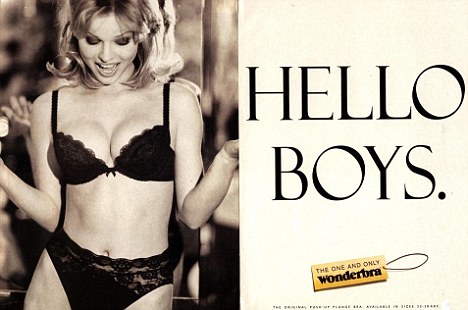Ask Anna: Women’s Undergarments
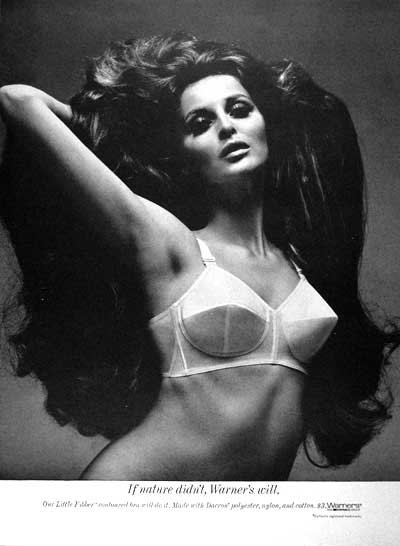
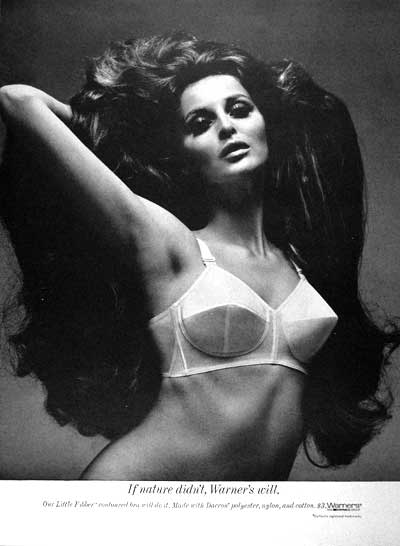
In a sense, undergarments are the omnipresent backbone of everyday style. They are the unseen supporters, the skeletons which shape our bodies beneath all of our garments – from push-ups to sports bras, or from boy shorts to Spanx, undergarments are the intermediary between our bodies and our publicly visible fashion.
It often seems in today’s lingerie marketing climate that undergarments are meant to evoke more of an air of sexiness and allure than function as practical garments. Some women feel a confidence boost, for example, from wearing pretty lingerie – an investment in beauty that they can keep secret to themselves. Why else do they come in so many variations of patterned embellishment if they’re not to meant to be seen (or seen by so few)? What’s practical about undergarments and why do we truly wear them?
Science seems to be decidedly anti-bra: In spring 2013, Professor Jean-Denis Rouillon of France concluded in a 330-woman study that breasts gain no “medical, physiological, or anatomical” benefit from having their breasts supported. In fact, they found bra-wearing to be associated with worse posture, worse muscle tone, and more tissue degradation. If they’re so bad for us, why in the world do we wear them every day? Is it really just for the aesthetic purpose of being shaped?
It turns out they’ve been doing the same, essential work of shaping us for literally thousands of years – to multiple different ends. The first undergarments, evidence of which originates in Egypt around 3000 BC, did not serve the same functions that ours do today, though they shared some overlap. For instance, upper class and high ranking women wore narrow tunics that started from below the breast and went to the ankle, held up by crossing shoulder straps. Women’s clothing was more conservative than men’s, often covering the full length of the leg. But interestingly, though the tunics were meant to mold the waist, their purpose was more to reveal the wearer’s status: the longer the garment, the higher the social class – slaves and servants wore nothing more than loincloths or bare skin.
 Undergarments remained a sort of status symbol into the Middle Ages, though that status was less tied to conservative standards than concerns about hygiene and cleanliness. Women of nobility wore simple dresses of linen – the same fabric we use today for practicality and temperature control – under their expensive outer layer of garments. The underdresses were warm, but mostly meant to protect nice clothes from the perceived filth of the body underneath them. Essentially, though clothes up until this time period were practical in a sense, they more often reflected the values of the culture and the status of whomever donned them.
Undergarments remained a sort of status symbol into the Middle Ages, though that status was less tied to conservative standards than concerns about hygiene and cleanliness. Women of nobility wore simple dresses of linen – the same fabric we use today for practicality and temperature control – under their expensive outer layer of garments. The underdresses were warm, but mostly meant to protect nice clothes from the perceived filth of the body underneath them. Essentially, though clothes up until this time period were practical in a sense, they more often reflected the values of the culture and the status of whomever donned them.
Later, in the 1500s, status became more inextricably tied to the shape of the body, and so undergarments became much more representative of attempts to accentuate and exaggerate cultural notions of beauty – functional, but not necessarily practical. The two main tactics used to exemplify or institute a woman’s childbearing hourglass shape were by adding on to the hips or whittling the waist, so undergarments from this time period fell into those two basic categories.
 Today, our dominant culture seems to project our attraction to a woman’s perceived fertility more onto the breasts than the hips, so one might say the push-up bra is the modern hoop skirt. The underskirts – called a farthingale – were basically petticoats stiffened (boned) with cane, whalebone, or wire by a series of hoops that drastically widened the silhouette at the hips. The boned shape was often reinforced by a “bum roll” – a sort of stiff crescent of material that sat on top of the upper hips, going around the small of the back. The top hoop of the farthingale was also tilted differently to accommodate the other big undergarment of the season (or, well, era): the tightened bodice.
Today, our dominant culture seems to project our attraction to a woman’s perceived fertility more onto the breasts than the hips, so one might say the push-up bra is the modern hoop skirt. The underskirts – called a farthingale – were basically petticoats stiffened (boned) with cane, whalebone, or wire by a series of hoops that drastically widened the silhouette at the hips. The boned shape was often reinforced by a “bum roll” – a sort of stiff crescent of material that sat on top of the upper hips, going around the small of the back. The top hoop of the farthingale was also tilted differently to accommodate the other big undergarment of the season (or, well, era): the tightened bodice.
Bodices originally were just laced pieces called “basquines” that one wore with a hooped skirt to keep your waist a bit tighter. They became full-blown corsets – one of fashion’s most historically controversial pieces – when some (possibly sadistic) person realized you could also add boning not just to build out from the body, but to restrict it and draw it in. Boning was inserted into the bodice or “basque,” stiffened cloth that one wore under or over her clothes to draw the waist in even more, and became the corset. It was when the basque started to be worn under the clothes that its decorative front emerged as a sort of “lover’s token” – similarly to how pretty lingerie is still a secret between a woman and her lover today.
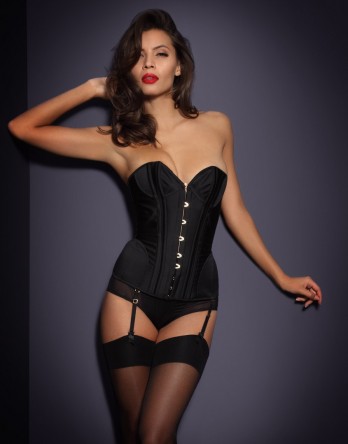
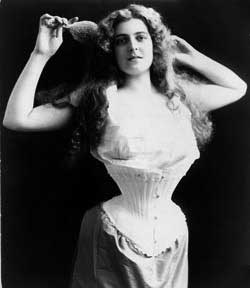
Of course, the more lingerie reshaped a woman, the more painful it became. Many historians have argued that the corset was responsible for organ deformities, miscarriages, and other health issues – all for fashion. More metaphorically, many a theorist has made the argument that the corset both physically victimized the woman and entrapped her in an erotic ideal.
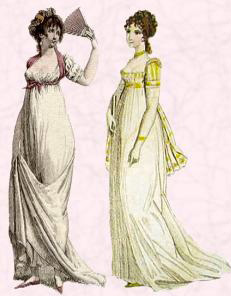 Even in the 1500s, French women knew that their undergarments were political vehicles. During the revolution, they discarded all of their tightly-bound underthings, which they found to be emblematic of the aristocracy, in favor of a Grecian-influenced, looser, classical aesthetic that mimicked the classical philosophical modes they were so inspired by politically. The next time rigid undergarments would truly die would be around World War I and the burgeoning women’s movement.
Even in the 1500s, French women knew that their undergarments were political vehicles. During the revolution, they discarded all of their tightly-bound underthings, which they found to be emblematic of the aristocracy, in favor of a Grecian-influenced, looser, classical aesthetic that mimicked the classical philosophical modes they were so inspired by politically. The next time rigid undergarments would truly die would be around World War I and the burgeoning women’s movement.
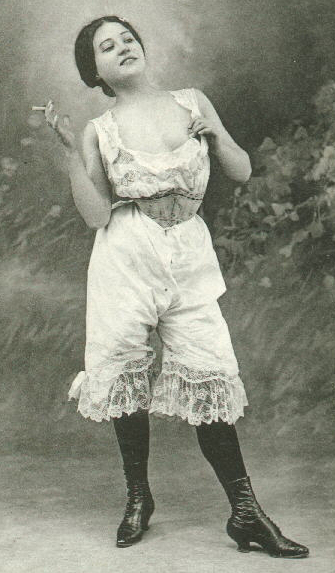 Other innovations in undergarments were spurred not quite by politics, but rather more from innovations in technology that occurred alongside women’s changing societal roles and literal increase of mobility. When the bicycle was invented at the end of the Victorian age, knickers and drawers were invented – the predecessors of panties, closer to shorts than skirts. This is when women started to have different sets of underwear for different purposes, just like modern gals have sports bras and boy shorts for comfort and activity, but bras and thongs for fashion.
Other innovations in undergarments were spurred not quite by politics, but rather more from innovations in technology that occurred alongside women’s changing societal roles and literal increase of mobility. When the bicycle was invented at the end of the Victorian age, knickers and drawers were invented – the predecessors of panties, closer to shorts than skirts. This is when women started to have different sets of underwear for different purposes, just like modern gals have sports bras and boy shorts for comfort and activity, but bras and thongs for fashion.
The bra was actually created for this same reason, even though we think of it as more restrictive today. Mary Phelps Jacob realized that corsets were hard to dance in, so she tied a few handkerchiefs together to create the first bra. Warner Brothers bought the patent and marketed it as a freer, softer lingerie alternative that made breasts look more natural.
 Things kept going back and forth for several decades between restriction and accentuation.The androgynous flapper look of the twenties saw women embrace a thinner silhouette by wearing tight girdles again – a “flatter” shape. In the thirties, it was all about accentuating girlishness again with bras that were strongly cupped and designed to add to, rather than distract from, the shape of the breast – which people were finally acknowledging as different from woman to woman. Warner Brothers introduced the “alphabet bra” in 1935 – alphabet referring, of course, to the four different lettered sizes, A, B, C, and D. (Today, you can buy anything from AAA to F.)
Things kept going back and forth for several decades between restriction and accentuation.The androgynous flapper look of the twenties saw women embrace a thinner silhouette by wearing tight girdles again – a “flatter” shape. In the thirties, it was all about accentuating girlishness again with bras that were strongly cupped and designed to add to, rather than distract from, the shape of the breast – which people were finally acknowledging as different from woman to woman. Warner Brothers introduced the “alphabet bra” in 1935 – alphabet referring, of course, to the four different lettered sizes, A, B, C, and D. (Today, you can buy anything from AAA to F.)
Bras became more malleable during World War II by necessity, not design. Steel, for example, a popular stiffening material (I know, ouch) wasn’t widely available because of the war, so synthetic materials were manufactured for the first time, like Lycra and rayon.
 After the war, once rationing was over, the voluptuous hourglass figure came even more into fashion, especially because of the advent of shapely Hollywood stars. Way before Madonna’s time, actresses famously endorsed cone-shaped bras that were designed to lift and accentuate the breasts. Remember Howard Hughes, the airplane engineer? He also spent some time designing bras for Jane Russell. That is how important the buxom, girlish aesthetic became.
After the war, once rationing was over, the voluptuous hourglass figure came even more into fashion, especially because of the advent of shapely Hollywood stars. Way before Madonna’s time, actresses famously endorsed cone-shaped bras that were designed to lift and accentuate the breasts. Remember Howard Hughes, the airplane engineer? He also spent some time designing bras for Jane Russell. That is how important the buxom, girlish aesthetic became.
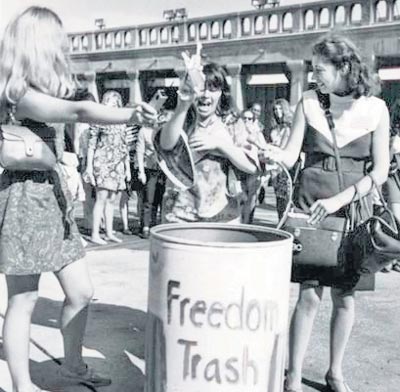 Lingerie exploded as consumer culture did, and manufacturers realized how personal a woman’s undergarments were to her and raced to develop new innovations and snatch up brand loyalty. Even as the hippie movements of the late 60s denounced and famously burned bras as signifiers of artificial standards, the everyday bra became easier to wear, more customizable in terms of fit, and never quite fell out of fashion. Remember the shoulder pads of the 80s? At about the same time, the padded bra came into popularity, culminating with the relaunch of the Wonderbra in the early 90’s. Concurrently, Victoria’s Secret started its domination over the definition of what makes a woman “sensual.” One could argue that today, though, it is women themselves who decide which definition of sensual they choose to entertain.
Lingerie exploded as consumer culture did, and manufacturers realized how personal a woman’s undergarments were to her and raced to develop new innovations and snatch up brand loyalty. Even as the hippie movements of the late 60s denounced and famously burned bras as signifiers of artificial standards, the everyday bra became easier to wear, more customizable in terms of fit, and never quite fell out of fashion. Remember the shoulder pads of the 80s? At about the same time, the padded bra came into popularity, culminating with the relaunch of the Wonderbra in the early 90’s. Concurrently, Victoria’s Secret started its domination over the definition of what makes a woman “sensual.” One could argue that today, though, it is women themselves who decide which definition of sensual they choose to entertain.
